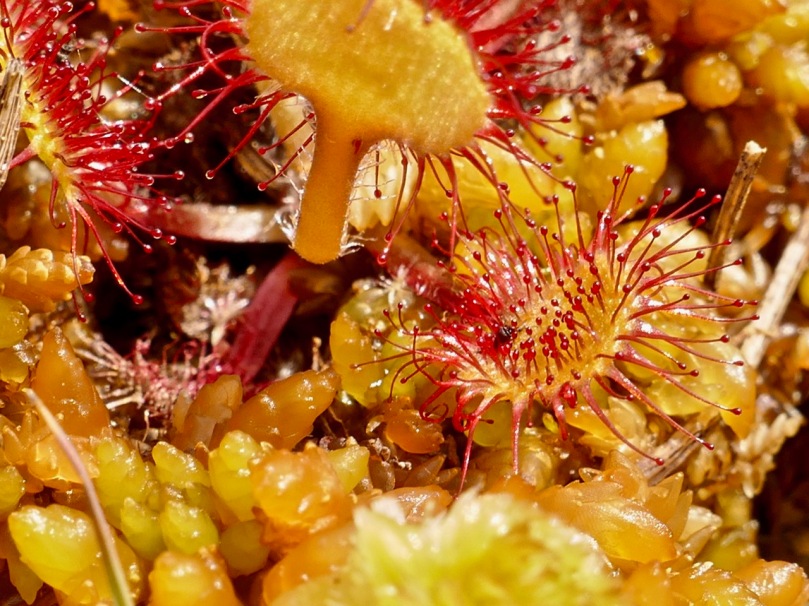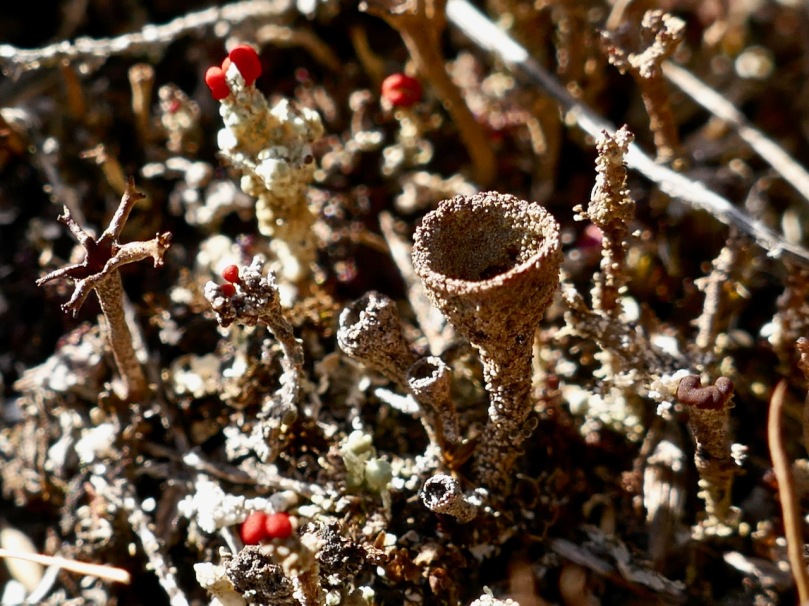A bog seems at first like an unpromising site for photography but all it takes is getting close. This isn’t as easy as it sounds, since bogs are wet places, but having arrived home sodden but exhilarated I’ve decided it’s definitely worth getting wet. My role model in this type of close observation is Tina Claffey, whose book, Tapestry of Light, and whose Facebook Page are constant sources of inspiration. Tina – thank you! We must be twin souls because like you I return again and again to the same patch of bog. Time loses meaning as I simply lie and let my eye tune in.
My little patch is quite close to my house and I described it in my post last year “The Wildest and Richest Gardens” – West Cork Bog Soaks. It’s taken a while this spring for the Cappaghglass soak to wake up but it’s well and truly alive now so here’s what’s there already.
On the rocks
First of all, the soak is surrounded by heather and rock. Lying on the rock, with my face a few centimetres from the surface, I have become aware of the rich lichen growth all around me. I don’t know a lot about lichens but I have been studying this one (above and below) – Devil’s Matchstick.
It’s obvious how it got that name, and it’s sometimes also known as Nail Lichen too. It’s only about a centimetre high, about the length of my little fingernail. The Latin name is Cladonia floerkeana. In Ireland we get this bright red form of it, whereas in North America the tips are black. The site I go to to learn about Lichens is http://www.irishlichens.ie. Here’s what they say about lichens on their home page:
Lichens are dual organisms; a fungus and one or more algae in a stable, mutually beneficial (symbiotic) partnership. The fungus provides structural form and protects the algae from extremes of light and temperature. Algae are capable of photosynthesis and some of the sugars produced provide the fungus with energy for growth and reproduction. Some lichens can live for many hundreds of years and being sensitive to pollution levels they are important environmental indicators.
There are several red-tipped lichens in the Cladonia group so I must look out for others. The trunk is described as squamulose which simply means scaly, at the bottom and becoming fruticose (or shrubby) as it grows. The stems are called podetia, and they are topped by the bright red apothecia. Yikes! Don’t think I’ll become a lichen expert in this lifetime.
And look at this one, that looks like a goblet – it’s another Cladonia but I don’t know which one. And lots of white lichen to boot. It’s a whole world down there on the rock, under our feet.
Let’s move over to the the bog soak now and look at two things in particular. The first is the Sundew. At first I thought it wasn’t up yet, but as I got closer I realised that it was just emerging from the surrounding Sphagnum moss (the second thing).
Besides looking weirdly otherworldly, the Sundew is a clever little critter, well adapted to this habitat. It’s developed a special mechanism to ensure it gets the nutrition it needs, since there isn’t much in the bog. It traps insects on its little sticky hairs, then the leaf rolls rolls over and digests them.
You might not want to watch this video if you have a weak stomach
The sundew does have a little white flower, but it’s the leaves that are the centre of all the action on this plant. Our bog soak has the Round-leaved Sundew, which is more common in Ireland than the Oblong-leaved Sundew that you saw in the video.
A hapless ant is this Sundew’s meal
Finally, as I was nosing around (er, literally) among the Sphagnum, I saw that some of them had these little brown caps and I wondered what they were. It turns out that mosses propagate by means of spores, and the caps are little exploding spore capsules. When they blow, they fire the spores great distances.
Take a look at the spores exploding in slow motion – it’s quite a sight.
Some of the capsules in my little patch had exploded already – you can see the empty cup-like capsules in the photograph below – at the bottom of the picture..
Sphagnum itself is an amazing moss – we wouldn’t have bogs without it, as it’s what holds all the moisture. The Irish Peatland Conservation Council has an excellent information page on Sphagnum. It includes this:
A huge number of tiny microscopic plants and animals live with Sphagnum mosses. A few drops of water squeezed from wet Sphagnum contains hundreds of microscopic species such as desmids, diatoms, algae, cyanobacteria, amoebae, rhizopods, flagellates, ciliates, rotifers (wheel organisms), worms, nematodes (round worms), flat worms and heliozoans (sun animals). One scientist counted over 32,000 microscopic animals from a Sphagnum moss growing in a bog pool!
Now that’s a bit too miniature for my lens. I’m happy at the magnification I can achieve with my Lumix. If you need me, you know where I’ll be.











Very informative. Did not realize how much life was within the sphaghnam moss. Very cool
LikeLiked by 1 person
As a total townie I’ve recently downloaded an app which scans and instantly identifies plants and things. I love it, as I know nothing 🙂 But I’m wondering if it might be stumped by your wonderful bog Finola.
LikeLike
I’ve heard good and bad about those apps, Roy. Which one are you using?
LikeLike
It’s called ‘Seek by iNaturalist’ Finola
LikeLike
Oh My! what wonder is to be found.
LikeLiked by 1 person
Very nice article on life in the bogs. Especially Sun Dew videos. Do Venus Fly traps exist there as well? So many times we drove past the bogs between Church Cross and Ballydehob without a thought about them as an ecosystem.
LikeLike
Thanks, Jeff. I believe Venus Fly Traps are native to North America. They probably need more heat than they’d get in an Irish bog.
LikeLike
Fantastic macro photography, all sorts of exciting things going on in bogs!
LikeLike
Thank you – I’m still a bit damp. 😊
LikeLike
Finola, I learn so much from you – thank you!
LikeLiked by 1 person
Wow. What great detail into the spores of Ireland. This is what we are made out of. This is what we used as turf to heat our homes. Grow our food and revel in its magic.
A close up of the cells of magic.
LikeLike
I agree, Denis – a bog is magic.
LikeLike